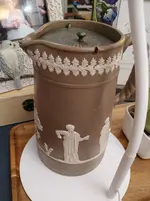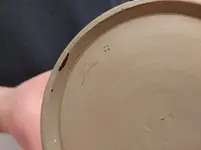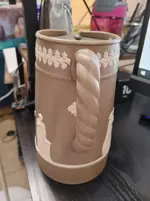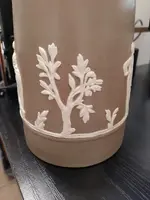It’s a nice jug, but not necessarily from Dudson. Unfortunately not terribly valuable and I would think a top-end price of about $50 would be about right for a pristine piece… but less than half that if damaged.
The following information is extracted and condensed from Angela Grant’s excellent ‘Ridgway Pattern Book’ website:
http://ridgwaypatternbook.org.uk/factories.html
The first thing to note is that rope-handled jasperware jugs were produced by the Ridgway group (mainly at their Bedford works) as well as by Dudson at their Hope Street works in essentially the same styles. The so-called ‘Tankard' shape jugs, coffee pots and 'cocoa jugs' in a multitude of decorative variations in this style, with and without lids made from ‘Britannia Metal’ seem to have arisen out of co-operation between the Ridgways and Dudson. The latter developed a cheaper process for production of jasperware and mosaicware (which they had been supplying chiefly to the hotel and Inn trade) and it appears that Dudson approached the Ridgways, seeking to take over production from them. The Ridgways perhaps agreed because their sales had been dropping and they were fearful of being undercut by Dudson's new process. The transfer appears to have taken place in several stages commencing with mosaicware in 1876/7 and jasperware in 1882.
Dudson only started to advertise jasperware in 1882 but output from the new process was initially small and the Ridgways continued to produce jasperware in the same styles (presumably with some sort of joint marketing agreement) until withdrawal from the market around 1891, leaving Dudson as sole producer. The Ridgways referred to the shape as ‘Paxton’ rather than ‘Tankard’. Neither Dudson, nor the Ridgways used date codes or maker marks during this period and pieces from both producers are generally unmarked, with the exception of the metal lids. You might have a look on the underside of that lid to see if there’s a patent reference… often a kite-shaped mark that gives the design registration patent date in a coded format.
The curved impressed “ENGLAND” mark was used by both Dudson and the Ridgways and, as you say, is generally attributed to the period between 1870-1899. However, in the absence of reliable date marks, doubts have been raised that this is the case and there is some belief that mark was introduced during the latter part of that period as a response to the US McKinley Tariff Act (taking force in March 1891) requiring country of origin marking on imported goods. The requirement continued until 1914 when the words “Made in…” were also stipulated.
The most common patterns for the Ridgways’ production are illustrated here:
http://ridgwaypatternbook.org.uk/church/rope.html#dudson1436
and for Dudson’s production here:
http://ridgwaypatternbook.org.uk/other/dudsonnewclass.html#dudsoncherubsa
Note that these are not exhaustive lists, and generally cover the later patterns from about 1882 onwards. I couldn’t see your exact pattern but note that the ‘Cherubs’ pattern in the second of those links has the same upper decorative border as yours.








 ? so my guess it's not easy to find info on it. I was given it for free on a local Buy Nothing group, so I'm surprised it is turning out to be quite interesting. Thanks for your help!
? so my guess it's not easy to find info on it. I was given it for free on a local Buy Nothing group, so I'm surprised it is turning out to be quite interesting. Thanks for your help!